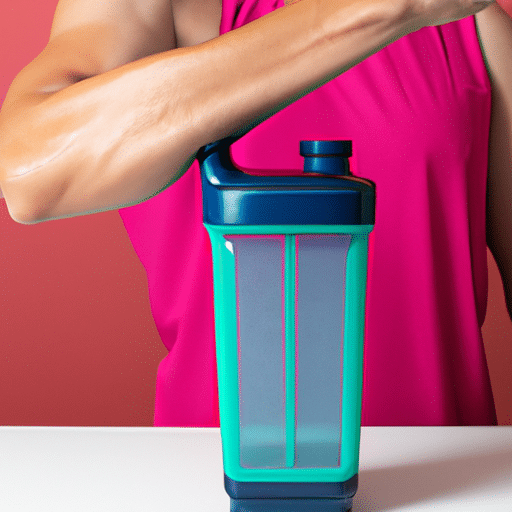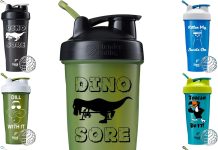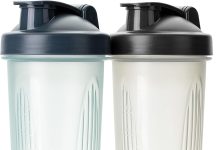Have you ever wondered how to incorporate your Blender Bottle into your fitness routine? Look no further! In this article, we will explore various exercises that you can do with a Blender Bottle to add a new level of challenge and excitement to your workout. Whether you’re a beginner or an experienced fitness enthusiast, these exercises will help you make the most out of your Blender Bottle while keeping you active and engaged. Get ready to shake things up!
Review contents
Exercises for upper body
Bicep curls
Bicep curls are a great exercise to target the muscles in your upper arm, specifically the biceps. To perform bicep curls, start by holding a dumbbell in each hand, palms facing forward. Keep your elbows close to your sides and slowly curl the weights up towards your shoulders, squeezing your biceps at the top of the movement. Then, lower the weights back down to the starting position and repeat for the desired number of repetitions. Bicep curls can be performed with a variety of equipment, such as dumbbells, resistance bands, or even household objects like filled water bottles.
Tricep extensions
Tricep extensions are a fantastic exercise for targeting the back of your upper arms, the triceps. To perform tricep extensions, start by holding a dumbbell or a household object with both hands and raise it above your head. Keep your elbows close to your ears and slowly lower the weight behind your head, bending at the elbows. Then, extend your arms back up to the starting position, squeezing your triceps. Repeat for the desired number of repetitions. Tricep extensions can also be done using a resistance band or cable machine for added variety.
Shoulder presses
Shoulder presses are a beneficial exercise for strengthening and toning your shoulder muscles. To perform shoulder presses, start by holding a dumbbell in each hand at shoulder level, palms facing forward. Engage your core and press the weights up towards the ceiling until your arms are fully extended. Slowly lower the weights back down to shoulder level and repeat for the desired number of repetitions. Make sure to keep your back straight and avoid using your lower body to assist with the movement. You can also perform shoulder presses using a barbell or resistance bands for variation.
Exercises for lower body
Squats
Squats are a compound exercise that work multiple muscles in your lower body, including your quadriceps, hamstrings, and glutes. To perform squats, stand with your feet hip-width apart and toes slightly turned out. Keep your chest up and your core engaged as you lower your hips back and down as if you’re sitting into a chair. Go as low as you comfortably can while keeping your heels on the ground, then rise back up to the starting position by driving through your heels. Repeat for the desired number of repetitions. For added challenge, you can hold weights or a kettlebell at your chest or perform jump squats for plyometric benefits.
Lunges
Lunges are another effective exercise for targeting your quadriceps, hamstrings, and glutes. To perform lunges, start by standing with your feet hip-width apart. Take a step forward with your right foot, lowering your body until your right knee is at a 90-degree angle and your left knee is hovering just above the ground. Push through your right heel to return to the starting position, then repeat on the other side by stepping forward with your left foot. Keep your core engaged and your chest up throughout the movement. You can also perform walking lunges to add an element of cardiovascular endurance.
Calf raises
Calf raises are a simple yet effective exercise for strengthening and toning your calf muscles. To perform calf raises, stand with your feet hip-width apart and toes pointing forward. Slowly rise up onto the balls of your feet, lifting your heels as high as possible. Hold for a moment at the top, then lower your heels back down to the ground. Repeat for the desired number of repetitions. To make calf raises more challenging, you can perform them on a step or with a resistance band wrapped around the ball of your foot.
Exercises for core
Russian twists
Russian twists are a fantastic exercise for targeting your obliques and building rotational strength in your core. To perform Russian twists, sit on the ground with your knees bent and feet flat on the floor. Lean back slightly and engage your core as you lift your feet off the ground, creating a V-shape with your body. Clasp your hands together and twist your torso from side to side, touching your hands to the ground on each side. Make sure to move from your core rather than just swinging your arms. Repeat for the desired number of repetitions.
Plank rotations
Plank rotations are an excellent exercise for targeting your entire core, including your abdominals, obliques, and lower back. To perform plank rotations, start in a high plank position with your hands directly under your shoulders and your body in a straight line. Engage your core as you lift your right hand off the ground and rotate your body to the side, extending your right arm towards the ceiling. Hold for a moment, then return to the starting position and repeat on the other side. Make sure to keep your hips level and your core engaged throughout the movement.
Bicycle crunches
Bicycle crunches are a dynamic exercise that targets your abdominals, obliques, and hip flexors. To perform bicycle crunches, lie on your back with your hands behind your head and your legs lifted off the ground, knees bent at a 90-degree angle. Engage your core as you bring your right elbow towards your left knee, simultaneously extending your right leg straight. Then, switch sides, bringing your left elbow towards your right knee and extending your left leg. Continue alternating sides in a fluid motion, as if you’re pedaling a bicycle. Aim to keep your lower back pressed into the ground throughout the exercise.
Exercises for full body
Burpees
Burpees are a challenging and effective exercise that work your entire body, providing cardiovascular benefits along with muscle toning. To perform burpees, start in a standing position with your feet hip-width apart. Lower into a squat position, then place your hands on the ground directly in front of you and jump your feet back into a high plank position. From here, perform a push-up by bending your elbows and lowering your chest towards the ground. Push through your hands to return to the high plank position, then jump your feet back towards your hands and explosively jump into the air, reaching your arms overhead. Land softly and immediately lower into the next repetition. Continue this movement pattern for the desired number of repetitions. Burpees can be modified to suit various fitness levels by performing them at a slower pace or eliminating the push-up or jump components if necessary.
Mountain climbers
Mountain climbers are a dynamic exercise that engage multiple muscle groups, including your core, shoulders, and legs. To perform mountain climbers, start in a high plank position with your hands directly under your shoulders and your body in a straight line. Engage your core as you drive your right knee towards your chest, then quickly switch and bring your left knee towards your chest while extending your right leg back. Continue alternating legs in a running motion, ensuring to keep your hips level and your core engaged throughout the exercise. You can perform mountain climbers at a quick pace for a cardiovascular challenge or slow them down to focus on stability and control.
Jumping jacks
Jumping jacks are a classic exercise that provide a full-body workout while also increasing your heart rate. To perform jumping jacks, start by standing with your feet together and your arms by your sides. Jump your feet out to the sides while simultaneously raising your arms overhead. Quickly return to the starting position by jumping your feet back together and lowering your arms. Continue this jumping motion for the desired number of repetitions. Jumping jacks are a great warm-up exercise or can be incorporated into a cardio circuit for added intensity.
Exercises for cardio
High knees
High knees are a high-intensity exercise that elevates your heart rate while also engaging your core and lower body. To perform high knees, start by standing with your feet hip-width apart. Lift your right knee up towards your chest as high as possible while simultaneously driving your left arm forward. Immediately switch and drive your left knee towards your chest, extending your right arm forward. Continue alternating knees in a running motion while maintaining a quick pace. Aim to bring your knees up to hip level or higher for maximum engagement. High knees can be performed as a standalone exercise or incorporated into a cardio circuit.
Jump rope
Jumping rope is a classic cardio exercise that can be done almost anywhere and requires minimal equipment. To jump rope, start by holding the handles of the rope in each hand and standing with your feet together. Swing the rope over your head and jump over it as it passes under your feet. Continue jumping over the rope in a fluid motion, coordinating your jumps with the rhythm of the rope. Start with a comfortable pace and gradually increase the speed as you become more proficient. Jumping rope is a great way to improve cardiovascular endurance and coordination.
Boxing punches
Boxing punches, such as jabs, hooks, and uppercuts, are an excellent cardio exercise that also engages your arms, shoulders, and core. To perform boxing punches, start by standing with your feet hip-width apart and your knees slightly bent. Make fists with your hands and bring them up to your face, elbows bent. Begin by throwing a series of quick, controlled punches with one arm, such as jabs (straight punches), hooks (angled punches), or uppercuts (upward punches). As you punch, rotate your hips and torso to generate power. Alternate between arms and continue for the desired duration or number of repetitions. Boxing punches can be done with or without equipment, such as using a punching bag or shadow boxing.
Exercises for flexibility
Standing quad stretch
The standing quad stretch is a simple but effective exercise for stretching the muscles in the front of your thigh (quadriceps). To perform the standing quad stretch, start by standing upright with your feet together. Use your right hand to grasp your right ankle or foot and bring it towards your glutes, bending your knee as necessary. Keep your knees close together and avoid arching your lower back. Hold the stretch for 20-30 seconds, feeling a gentle stretch in the front of your thigh. Release and switch sides, repeating the stretch on your left leg. The standing quad stretch can be done anywhere and is especially beneficial after lower body workouts or as a part of your stretching routine.
Hamstring stretch
The hamstring stretch targets the muscles on the back of your thighs, helping to improve flexibility and relieve tightness. To perform the hamstring stretch, start by sitting on the ground with your legs extended in front of you. Keep your spine tall and reach forward, trying to touch your toes or as far as you can comfortably reach. Avoid rounding your back and aim to feel a gentle stretch in the back of your thighs. Hold the stretch for 20-30 seconds, then release. You can also perform the hamstring stretch lying on your back and using a towel or resistance band to assist with reaching your toes.
Tricep stretch
The tricep stretch is a great exercise for targeting the muscles on the back of your upper arms. To perform the tricep stretch, start by standing or sitting with your feet shoulder-width apart. Raise your right arm overhead and bend it at the elbow, bringing your right hand towards the middle of your upper back. With your left hand, gently press on your right elbow to deepen the stretch. Keep your shoulders relaxed and avoid straining. Hold the stretch for 20-30 seconds, feeling a gentle pull in your tricep muscle. Release and repeat the stretch on your left arm. The tricep stretch can be done as part of your upper body warm-up or post-workout stretching routine.
Exercises for balance
Single-leg deadlifts
Single-leg deadlifts are an excellent exercise for improving balance and targeting your hamstrings and glutes. To perform single-leg deadlifts, start by standing with your feet hip-width apart. Shift your weight onto your left leg and hinge forward at the hips, extending your right leg straight behind you. Keep your back flat and reach your hands towards the ground as you lower your torso parallel to the floor. Return to the starting position by squeezing your left glute and driving your hips forward. Complete the desired number of repetitions, then switch to the other leg. Single-leg deadlifts can also be performed while holding a dumbbell or kettlebell to increase the challenge.
Tree pose
Tree pose is a yoga exercise that improves balance, stability, and concentration. To perform tree pose, start by standing tall with your feet together. Shift your weight onto your left foot and place the sole of your right foot against the inside of your left leg, above or below the knee. Avoid placing your foot directly on the knee joint. Bring your hands to prayer position at your heart or extend them overhead. Focus on a stable point in front of you for balance and hold the pose for 30-60 seconds. Release and repeat on the opposite leg. Tree pose can be modified by keeping the toes of the lifted foot on the ground for added stability.
Heel-to-toe walk
The heel-to-toe walk, also known as the tandem walk, is a simple exercise that challenges your balance and coordination. To perform the heel-to-toe walk, start by standing with your feet together and your arms by your sides. Step forward with your left foot, placing the heel directly in front of your right toes. Then, bring your right foot forward and place the heel directly in front of your left toes. Continue walking in a straight line, placing one foot in front of the other with each step, ensuring heel-to-toe contact. Aim to maintain a slow and controlled pace, focusing on stability and balance throughout the exercise.
Exercises for coordination
Figure 8 arm circles
Figure 8 arm circles are a coordination exercise that targets the shoulder muscles and improves overall upper body mobility. To perform figure 8 arm circles, stand with your feet hip-width apart and extend your arms straight out to the sides. Begin by making clockwise circles with your arms, gradually decreasing the size of the circles. After a few rotations, switch to counterclockwise circles and continue for the desired duration. As you feel more comfortable, start crossing your arms over each other, creating a figure 8 motion with your circles. Focus on maintaining a smooth and controlled movement pattern throughout.
Speed skaters
Speed skaters are a dynamic exercise that improves coordination, agility, and leg strength. To perform speed skaters, start by standing with your feet together and your arms by your sides. Take a big step to the right with your right foot, simultaneously swinging your left arm across your body. Push off your right foot and leap to the left, this time bringing your right arm across your body. Continue moving laterally, alternating sides in a fluid motion, as if you’re skating from side to side. Bend your knees and engage your core for added stability and power. Speed skaters can be done at a quick pace for a cardiovascular challenge or at a slower pace to focus on form and control.
Jumping lunges
Jumping lunges are a coordination exercise that targets your leg muscles and adds a plyometric element to your workout. To perform jumping lunges, start in a lunge position with your right foot forward and your left foot back, both knees bent at a 90-degree angle. Engage your core and explosively jump into the air, quickly switching the position of your legs mid-air. Land softly with your left foot forward and your right foot back, immediately lowering into the next lunge. Continue alternating sides, using your arms for balance and momentum. Jumping lunges can be modified by reducing the intensity or reverting to traditional static lunges.
Exercises for strength
Resistance band exercises
Resistance band exercises are an excellent way to build strength without the need for heavy weights or machines. With a variety of resistance bands available, you can target different muscle groups and adjust the intensity based on your fitness level. Examples of resistance band exercises include bicep curls, tricep extensions, lateral raises, squats, and glute bridges. To perform resistance band exercises, securely anchor the band and hold or step on the other end to create tension. Maintain proper form and perform the desired movement while maintaining tension on the band. Resistance band exercises can be incorporated into a full-body strength routine or used as a standalone workout.
Weighted squats
Weighted squats are a fantastic exercise for building lower body strength, particularly in your quadriceps, hamstrings, and glutes. To perform weighted squats, start by holding a dumbbell or kettlebell in front of your chest or resting a barbell across your upper back. Stand with your feet hip-width apart and toes slightly turned out. Lower your body into a squat position, keeping your chest up, knees in line with your toes, and lowering until your thighs are at least parallel to the ground. Push through your heels to return to the starting position and repeat for the desired number of repetitions. Weighted squats can be performed with various equipment to suit your preferences and fitness level.
Push-ups
Push-ups are a classic exercise that target your chest, shoulders, and triceps while also engaging your core. To perform push-ups, start in a high plank position with your hands directly under your shoulders and your body in a straight line. Engage your core and bend your elbows, lowering your chest towards the ground while keeping your elbows close to your sides. Push through your hands to extend your arms and return to the high plank position. If full push-ups are too challenging, you can modify by performing them on your knees or against a wall. Aim to increase the number of push-ups you can do over time to build strength and endurance.
Exercises for endurance
Plank hold
The plank hold is a powerful exercise for building core strength and endurance. To perform a plank hold, start in a high plank position with your hands directly under your shoulders and your body in a straight line. Engage your core, squeeze your glutes, and avoid sagging your hips or lifting them too high. Hold the position for as long as possible, maintaining proper form and breathing steadily. Aim for at least 30-60 seconds and gradually increase the duration as your endurance improves. The plank hold can also be performed on your forearms or with variations, such as side planks or plank jacks.
Cycling
Cycling is a low-impact exercise that builds cardiovascular endurance and strengthens your leg muscles. Whether you prefer riding outdoors or using a stationary bike, cycling provides an effective way to improve your endurance and burn calories. Start with a moderate pace and gradually increase the resistance or speed as you become more comfortable. Aim for at least 30 minutes of cycling per session and incorporate intervals or hill climbs for extra challenges. Cycling is also a great way to explore new areas, enjoy the outdoors, and engage in group activities or classes.
Running or jogging
Running or jogging is a popular form of cardiovascular exercise that can be done almost anywhere and at any fitness level. It improves endurance, strengthens your leg muscles, and boosts overall cardiovascular health. To start, wear proper running shoes and find a suitable location such as a track, trail, or gym treadmill. Begin with a warm-up and gradually increase your pace or distance over time. Aim for at least 20-30 minutes of running or jogging, and adjust the intensity based on your fitness level and goals. Remember to listen to your body, incorporate rest days, and stretch before and after your runs to prevent injuries.
By incorporating these exercises into your fitness routine, you can target different areas of your body, improve your cardiovascular health, build strength and endurance, enhance coordination and balance, and increase your flexibility. Remember to start at your current fitness level and gradually progress as you become more comfortable and stronger. Consistency and proper form are key, so listen to your body, stay hydrated, and always warm up and cool down before and after your workouts. With dedication and a positive mindset, you can achieve your fitness goals and enjoy the many benefits of a well-rounded exercise program.

































